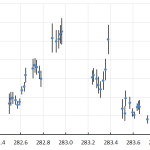Ivan Sergei1
1 Mira Str.40-2, 222307, Molodechno Belarus
seriv76@tut.by
Abstract: This article presents the results of radio observations made in January 2021. The results of the radio observations are compared with the CAMS video network summaries.
1 INTRODUCTION
The observations were carried out at a private astronomical observatory near the town of Molodechno (Belarus) at the place of Polyani. A 5 element-antenna directed to the west was used, a car FM-receiver was connected to a laptop with as processor an Intel Atom CPU N2600 (1.6 GHz). The software to detect signals is Metan (author – Carol from Poland). Observations are made on the operating frequency 88.6 MHz (the FM radio station near Paris broadcasts on this frequency). “The “France Culture” radio broadcast transmitter (100 kW) I use is at about 1550 km from my observatory which has been renewed in 1997.
The purpose of the radio observations was to monitor the activity of the main meteor streams to patrol the activity of the Quadrantid meteor shower, and to check the activity of the sporadic background meteors. Listening to the radio signals 1 to 3 times a day for one hour was done in order to control the level of the hourly activity, as well as to distinguish between periods of tropospheric passage and other natural radio interference. The total effective listening time was 83 hours. In order to quickly search for signals of the radio fireballs, the program SpectrumLab was running in parallel to the Metan program.
2 QUADRANTIDS (QUA#0010)
Peak Quadrantid activity was recorded at the 11h–14h UT interval with hourly signal numbers of 250, which corresponds well to the 2021 Meteor Shower Calendar data (Rendtel, 2020). My result agrees well with the IMO data. According to IMO data, a high peak activity was observed from about 12h to 16h UT on January 3. Unfortunately, the IMO has no data on flux activity within that time interval.
The hourly numbers while listening to the radio echoes were as high as 600 signals. This can be explained by the fact that the human ear is a more sensitive organ in terms of detecting weak signals at the limit of recognition, which the software cannot detect. My numerous experiments with reducing the trigger threshold for the Metan software in order to better detect weak and very weak signals were not successful – the software detects false alarms. In this regard, a certain trigger for musical-speech signals of meteors was found and set experimentally. Figure 1 Shows the maximum of minor meteor showers in black, medium activity showers in blue, variable activity showers in green and the major meteor shower in red.

Figure 1 – Radio meteor echo counts at 88.6 MHz for January 2021.

Figure 2 – Heatmap for radio meteor echo counts at 88.6 MHz for January 2021.

Figure 3 – The result with the calculated hourly numbers of meteor echoes by listening to the radio signals for January 2021.
It was not possible to isolate the peak of the low gamma Ursae Minorids (GUM#0404) activity in a reliable way. Some increase in signal activity has been observed around January 18 while listening to the meteor echoes and on January 22 when echoes were automatically being detected. On January 10, I counted an increased level of hourly echo activity (140), while the background level of activity was between 30–45 signals. My observations are confirmed by the CAMS video network, which shows an increase in shower meteor and sporadic meteor activity not only on January 10, but also on January 11 (Figure 4).

Figure 4 – Daily meteor activity according to CAMS video networks in January 2021.
The graph of the radio echo activity shows that the activity of radio signals decreased after January 19. My observations are confirmed by data from the CAMS video networks, showing a decrease in the meteor shower activity and sporadic background after January 19.

Figure 5 – Daily video meteor activity in January 2021 according to CAMS video networks.
3 Fireballs.
For fireball activity statistics, I have selected signals from the log files with a peak power greater than 10000 as fireballs and with a signal duration greater than 10 seconds. Some correlation between the radio fireballs and CAMS video meteor activity is noticeable. From the graph we can conclude that the large meteoroid particles that produce radio fireballs are distributed very irregularly in space.

Figure 6 – Daily activity of radio fireballs in January 2021.
ACKNOWLEDGMENT
I would like to thank Sergey Dubrovsky for the software they developed for data analysis and processing of radio observations (software Rameda). I thank Karol from Poland for the Metan software. Thanks to Paul Roggemans for his help in the lay-out and the correction of this article.
REFERENCES
Jenniskens P., Baggaley J., Crumpton I., Aldous P., Pokorny P., Janches D., Gural P. S., Samuels D., Albers J., Howell A., Johannink C., Breukers M., Odeh M., Moskovitz N., Collison J. and Ganjuag S. (2018). “A survey of southern hemisphere meteor showers”. Planetary Space Science, 154, 21–29.
P. Jenniskens, P. S. Gural, L. Dynneson, B. J. Grigsby, K. E. Newman, M. Borden, M. Koop, D. Holman. 2011. CAMS: Cameras for Allsky Meteor Surveillance to establish minor meteor showers. Icarus 216, 40–61.
Rendtel Jurgen (2020). “Meteor Shower Calendar”. IMO.




